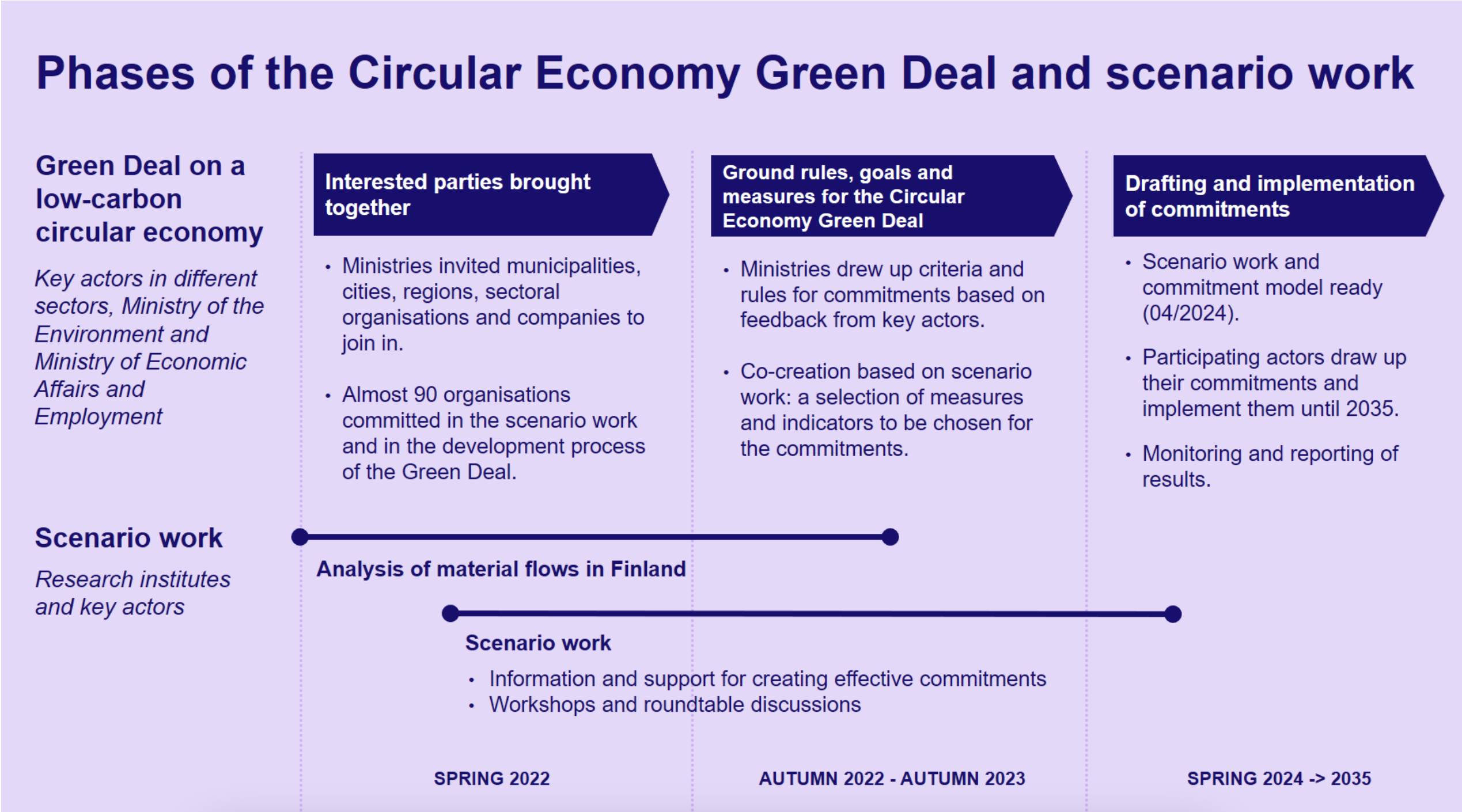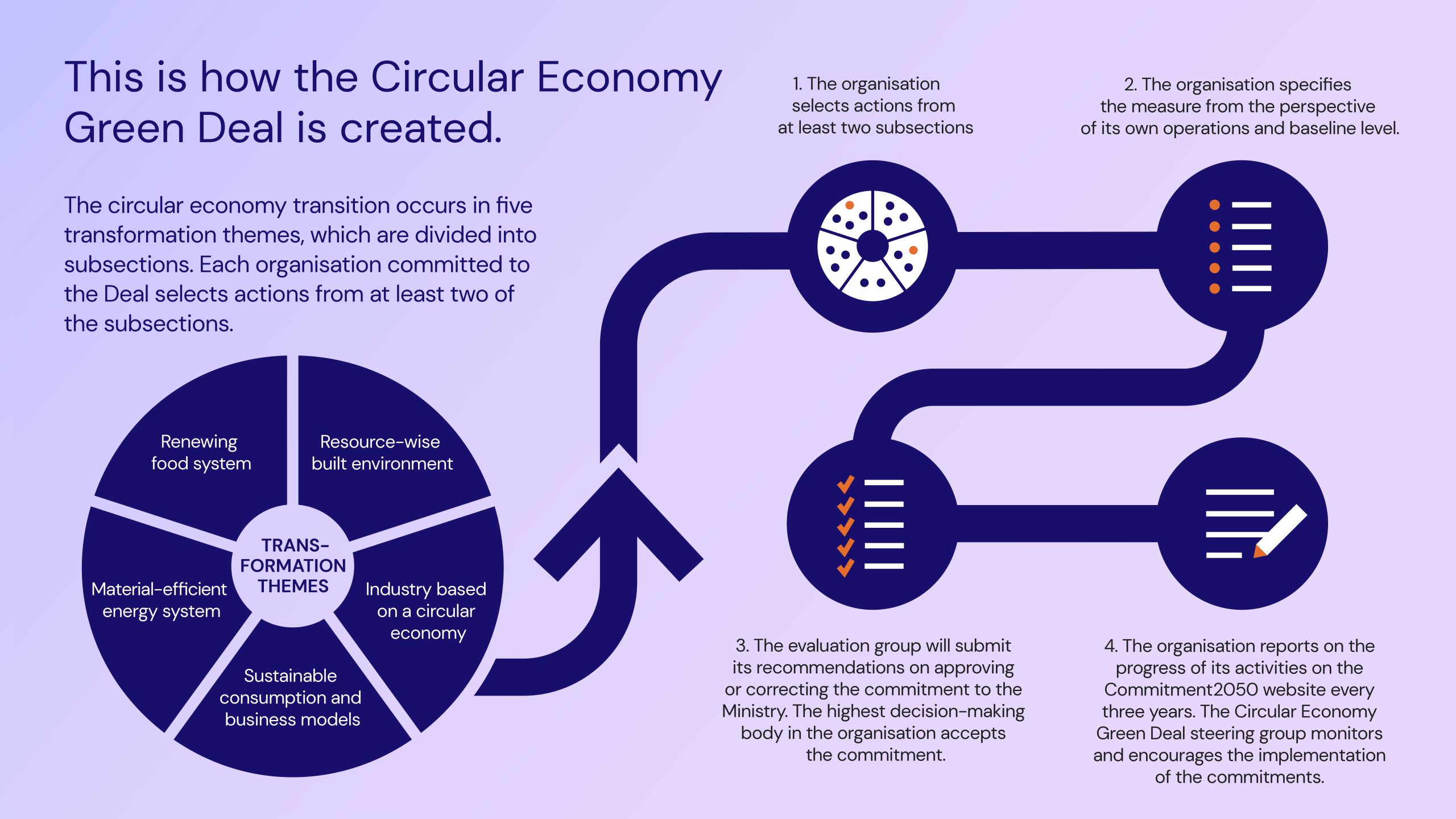The Circular Economy Green Deal is a novel Finnish steering instrument that catalyses collective action for systemic change towards circularity based on voluntary commitments. On a national scale, it brings together a wide range of stakeholders, policymakers and research to deepen understanding of needed changes, set ambitious science-based targets, and build collective action needed for a circular transition. This policy tool is one of the key implementation actions of Finland’s strategic programme in making carbon-neutral circularity the new foundation of the Finnish economy by 2035. We at Demos Helsinki had the honour of leading the co-creative process that led to the creation of the Circular Economy Green Deal.
Globally, initiatives to advance circularity are gaining policy momentum.
With growing recognition of the potential of a circular economy in tackling climate and economic challenges by reducing natural resource consumption, nations across the globe have taken steps to advance and institutionalise a circular approach.
In the Netherlands, to achieve a national strategy to be fully circular by 2050, the central government has collaborated with a diverse network of actors, including public authorities, academia, environmental organisations, industry, trade unions, and others, to develop smarter and more efficient approaches to using products and raw materials. Germany, being a heavy industrial economy, has also committed to strengthening recycling systems with extended producer responsibility, advanced by their Circular Economy Act, (Kreislaufwirtschaftsgesetz), aiming to conserve natural resources and ensure environmentally compatible waste disposal. Japan, among other countries, published a Material Flow Data Book already in 1999 and enacted the Construction Material Recycling Law in 2000, implementing the registration system for demolition contractors and effective recycling of construction materials (including concrete, asphalt concrete, and timber.).
In Finland, the strategic programme for a circular economy aims to make circularity the new foundation of the national economy by 2035. The three key objectives of the programme are:
– The consumption of non-renewable natural resources decreases and the sustainable use of renewable natural resources can increase in such a way that the total consumption of domestic primary raw materials in 2035 does not exceed the 2015 level. This objective does not apply to natural resources used for manufacturing export products.
– Resource productivity will double by 2035 from the 2015 level.
– The circular material use rate (CMU) will double by 2035.
But, the transition to a circular economy is still in gridlock.
Despite these efforts, our economies are still based on linear models. Only 7% of materials are recycled globally. According to the UN, without any urgent and concerted action, global resource extraction could surge by 60% between 2020 and 2060, contradicting what is called for to limit global heating according to the UNFCCC Paris Climate Agreement.
The average Finn consumes 100 tons of natural resources per year—more than anywhere else in Europe. Finland also falls behind other EU member states in circular material rates, signalling the need for significant improvement to reach both national and European targets.
Transitioning to a circular economy requires more than small-scale, individual pilot projects. Key factors to a successful transition include deeper cooperation between sectors, increased policy coherence, implementation and scaling of innovations, and long-term commitment to action aiming at systemic change.
To get there, we need collective action towards shared goals. This paints a commonly shared challenge across many societies when it comes to urgent transitions. Collective action is too slow (or absent), reinforcing the voices claiming that the transition is a lost cause. But it isn’t. The Circular Economy Green Deal attempts to provide a governance model and incentives for action across all relevant market shapers (private and public sector, as well as science and research).
Uniting parallel processes through multilateral collaboration, the Circular Economy Green Deal takes its shape.
Led by Finland’s Ministry of Environment and the Ministry of Economic Affairs and Employment, the Circular Economy Green Deal is a policy tool designed to catalyse cross-sector strategic collaboration, driving a systemic transition towards Finland’s national circularity targets.
Since 2022, several ministries, six research institutes, and over 90 organisations, including key businesses, major cities and regions, and industry associations across Finland, have participated in scenario planning and developing the Circular Economy Green Deal. This diverse array of contributors enabled a balance of science- and practice-based insights used to create the tool.
In parallel with the Circular Economy Green Deal’s development, research institutes and key actors conducted scenario analysis to assess current resource flow and identify impactful actions by outlining different scenarios. Aligning these two work streams created a synergistic and co-influential process that enabled unprecedented collaboration between public, private, and research entities.
Together, they explored key issues on a scientific basis, including:
– the current state of circularity in different sectors.
– how national targets would translate into changes in these sectors.
– who needs to be involved and which specific actions would effectively reduce natural resource consumption and help reach the goals.
Bridging research and practical experiences in a collaborative approach, the Circular Economy Green Deal serves as a unique steering instrument that allows ministries to incentivise and support actors in setting ambitious, science-backed targets and actions for circularity.
In short, the four building blocks of the process to create the Circular Economy Green Deal are:
– Science-based policy: Research institutes provide analysis and knowledge of natural resource consumption.
– Building consensus on goals: Key actors are involved in setting targets and recognising impactful measures.
– Devolving problem-solving: Actors have the autonomy to pursue the shared goals as they see fit within a joint framework.
– Commitment to iteration through learning: Mechanisms for learning and cooperation help shape impactful policies and measures, and build opportunities for continuous development.

Expected benefits of the Circular Economy Green Deal
– The Circular Economy Green Deal aims to facilitate the systemic circular transition by: (i) generating legitimacy, (ii) creating a shared understanding of the need for a circular economy and its bottlenecks among actors across sectors, and (iii) facilitating cross-sectoral peer learning on good practices and experiments.
– It creates new business opportunities and economic competitiveness, as all participating organisations together have a consensus on required actions and gain access to necessary collaboration networks.
– This, in turn, supports Finland’s progress toward its goal of carbon neutrality and a sustainable economy by 2035.
Organisations’ commitment to the Circular Economy Green Deal
The Circular Economy Green Deal supports organisations from all industries in identifying the most effective circular economy measures and encourages them to transform operations, not only at the home organisation level but also across the entire sector.
For ministries, it provides knowledge and increased granularity on avenues for potential circular policies and steering.
This is what the commitment process looks like:

Demos Helsinki’s contribution & next steps
Demos Helsinki had the opportunity to lead the co-creative process behind the development of the Circular Economy Green Deal in close collaboration with the Ministry of Environment and Ministry of Economic Affairs and Employment and the involved research institutes.
This included:
– Connecting the scenario work with the developing process of the Circular Economy Green Deal.
– Instigating and managing iterative and meaningful dialogue and co-creation between actors.
– Advancing a coherent understanding of shared targets to enable ambitious cross-sectoral movements and commitments towards action.
Demos Helsinki also supported the ministries in developing the governance model for the Circular Economy Green Deal.
Key values of the humble governance framework–one of our core approaches at Demos Helsinki–centred on trust, collaboration, autonomy, peer learning, and iteration— was a foundational approach in the successful collaborative process.
This work builds on the long experience and history Demos Helsinki has with developing 21st-century governance and collective action to tackle the environmental crises of our time. Demos Helsinki supported the same two ministries in creating the Strategic Programme for a Circular Economy in 2019.
For the next steps, we will focus on supporting the ministries in facilitating organisations to join the Circular Economy Green Deal with ambitious and impactful commitments to circularity. At the same time, we will continue identifying and building ecosystems of change to tackle the current systemic bottlenecks.
Only through cross-sectoral collective action can systemic bottlenecks be solved.
Brief grasp of the Circular Economy Green Deal: READ THE SLIDE SUMMARY
Learn more about the Circular Economy Green Deal here.
Interested in the project? Get in touch with
Otso Sillanaukee
otso.sillanaukee@demoshelsinki.fi
+358 50 544 5922
Cecilia af Hällström
cecilia.afhallstrom@demoshelsinki.fi
Satu Lähteenoja
satu.lahteenoja@demoshelsinki.fi
+358 44 500 2993
Juha Leppänen
juha.leppanen@demoshelsinki.fi
+358 40 700 6585
Featured image: Landiva Weber / Pexels